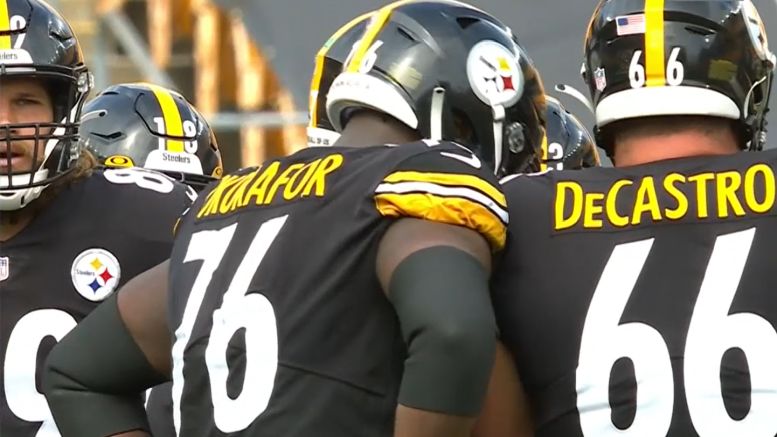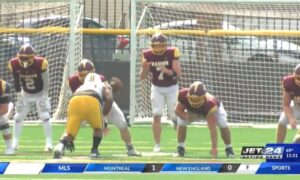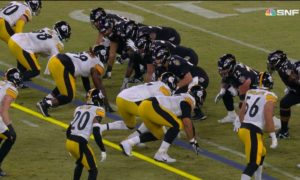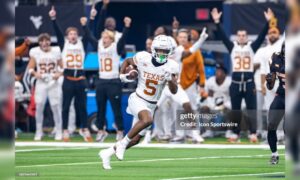The more I think about it, the more I think Kevin Colbert has been one step ahead of us yet again. Pittsburgh is going to go with the best player available (BPA) in Round 1, without any finger on the scale in favor of an Offensive Tackle. The numbers suggest that as the most likely outcome – there are a lot of good Tackles – but it’s far from written in stone.
Here’s my thinking. First, please compose your own scouting profile on Al Villanueva. Ready? I bet it reads something like mine:
Next step. Please compose your own scouting profile of Chuks Okorafor. Has the penny dropped? You might as well block, copy and paste. And that, I am coming to believe, says quite a lot about the Steelers’ 2020 issues on the offensive line.
First, it explains why Zach Banner was able to beat out Okorafor for the starting Right Tackle job. Banner, like Feiler, is very powerful man with good length and adequate feet. He pairs well with Villanueva because one does “A” exceptionally well but is only okay at “B”, while the other specializes in “B” but is only solid at “A”.
Second, it explains both the struggles in the running game, and the ability to keep Roethlisberger upright despite throwing what seemed like thousands of balls every game. With Feiler at Guard and Banner hurt, the team had two OT’s who excelled at positional blocking and no one to create power in the run game. Especially without a blocking TE and/or a healthy Fullback.
To test this, please make a Villanueva copy in your head and move him to Right Tackle in place of Okorafor. Play both of the AV clones. Are your results any different? Not mine.
The good news is this: We all expect Villanueva to move on in free agency, with some new team offering a good bit more than Pittsburgh is willing to pay. If Villanueva = Okorafor, the team’s situation at Left Tackle will not degrade except for Chuks’ final learning curve as a blindside starter. We lose our depth, but not our front line quality.
The same is true at Right Tackle if Banner and/or Feiler returns . The team will have both spots covered with acceptable starters. Thus the remaining issue will be depth, unless they can find a reliable swing Tackle. Re-signing Feiler (unlikely at best) will help, but neither he nor Banner project well as blindside protectors if Chuks got injured. We would have 2020 in reverse, with two power Tackles and inadequate pass protection against speed rushers.
So What Does That Mean For The Draft?
First, do you agree with me? I am hardly god’s gift to the world as an OL analyst. There are people I respect who have a dimmer view of Chuks Okorafor, and others who feel the same toward Banner. That changes the wants & needs analysis.
If you write off Chuks, you have to worry that the team will have no capable Left Tackle on the roster unless they break the bank to re-sign Big Al. You’ll need to go into the draft in desperation mode, with a very strong finger on the scale for high floor prospect capable of being a blindside protector in the immediate future. “Potential” will be a secondary concern because the blindside hole will be getting your QB killed.
If you have a dimmer view of Banner, then you’ll be desperate to re-sign Feiler rather than Villanueva, and will put your finger on the scale for high-floor, power oriented RT prospects. Those are a lot more common, luckily enough.
But let’s assume you do agree. In that case, Pittsburgh has two starters who both grade out as “acceptable” for their respective positions. The team may draft another in order to improve from acceptable to good. That will depend on who is available. But the team should draft another to address the depth concerns.
Healthy teams will have four or five OT’s on the roster: two starters, a swing Tackle backup, and a developmental guy or two in the pipeline. The OT3 may not be as good as the starters, but he needs to be solid enough to start. High floor. The pipeline guys, by contrast, are all about potential. Young OT’s usually have fatal technique holes in their game that take at least 2-3 years of hard work to fix. The pipeline players should be ones who have the potential to be stars when they finish that prospect, not just ready-to-play contributors.
Two Digressions
First, I feel a need to defend Zach Banner before moving on. I was doing these Big Boards back in 2017 when he was a prospect, and can summarize his scouting profile pretty easily:
- a 6’8″ colossus who is at least 50 lbs. overweight and may have above-the-shoulders problems to explain that. Immensely athletic for his size, he could have been a Round 1 prospect as a RT with legitimate LT dreams. But those concerns are going to drop him into the middle rounds or worse if the interviews don’t go well.
Put another way, take Josh Carney’s recent scouting report on Teven Jenkins, add 3-4″ of length plus 50 lbs. of flab, and then factor in the concerns about why his weight ballooned so much. You end up with a Round 4-6 prospect, which is exactly where Banner went. He then lost all control, added even more weight, and found himself on the verge of getting dropped out of the league entirely. He responded by growing up, developing the self discipline to drop almost a hundred pounds of excess weight, and then get to work on his craft. That triumph of will turned him into the player we see today: a colossus who can move opponents where he wants them to go, with enough athleticism to survive quite well in pass protection. I haven’t seen either the genius level footwork or super advanced skill to play on the blindside, but who knows what the future might bring? He’s a late bloomer, after all, who essentially lost the first 2-3 years of his career to his internal fight.
It is a great story, and he deserves our respect and admiration for coming through that struggle on top. This isn’t some Round 4 trailer trash we’re talking about. It is a formerly self destructive fringe-1st talent, who has taken his entire rookie contract to get over those self-created problems.
Second, I want to give a shout out to all the Depot film watchers who are doing such yeomen’s work in helping us dig past the broad brush Internet scouting profiles, and down toward the details that distinguish players from stereotype patterns. Most of the readership here is going to be like me: we don’t do that hard film crunching, and instead try to create a gestalt picture by seeing through multiple lenses put up across the Internet. My Big Board started as nothing more than an effort to keep notes on all that. Who said what again, and who was it about? And did I find it convincing? The Board accordingly owes everything to the people who create those lenses, and especially the ones who do a careful, well documented job.
But here’s the thing: scouting reports almost always have an unavoidable flaw. Good reviewers will tell you what the player is good at, what he does badly, the athletic skills he brings to the table, the athletic limitations, and sometimes how all that projects to particular schemes. Average ones (I will not call anyone poor when they are doing us all this service!) omit some part of that list and/or rely on fewer games in reaching their conclusions. Very good reviewers will also give you an idea of what it will take to fix the technical flaws. And top notch reviewers will even add in some analysis of whether the player has the physical tools to fix those flaws.
What’s missing? The thing we most want to know! What will this player look like in 3-5 years?
That is too much to expect, of course. Anyone who could reliably give that answer would be working as a professional scout and getting paid a gazillion bucks because none of his peers can do it reliably. But those pros will speculate, because that is what they are paid to do. Informed projection is the real, bottom line purpose of a draft grade.
Internet scouts will very rarely go that far because (a) they know that they’ve only looked at a few games, (b) they only have access to film, and (c) better to just stay mum than get a reputation for being irresponsible and misleading for the sake of clicks and short term popularity. All right, proper, and true. But that is the point we are trying to reach!
This is why we have such spirited conversations in the Comments sections. That is the only place where those of us who obsess about these things can fish for true speculation, hunches, and impressions while preserving the authors’ right to put asterisks on all those fuzzy opinions.
Looking At The Prospects
2021 has the potential to be a legendary class of Offensive Tackles because there are excellent prospects of every description. But they aren’t the same, and it is inherently wrong to rank them in order on some single continuum of better to worse. We need to divide them up into categories, and then rank them within those different types.
I count three (3) superior prospects who combine all-star ceilings, solid floors, and the pure athleticism to succeed as both blindside protectors and dig-em-out power guys in the run game. These are Penei Sewell, Rashawn Slater, and Christian Darrisaw. If any of those fall to 1:24 the Steelers pick will be obvious.
Then there are two (2) relatively boom or bust prospects, who have the athleticism to be all-around pro bowlers but have not proved as much on the field because they are relative babies at 20 years old. These are Samuel Cosmi and Jalen Mayfield. Hair splitters will suggest that Cosmi leans more toward the LT side of the spectrum and Mayfield toward RT, but I believe those leanings are swallowed up by the amount of projection needed to get from where they are now to where they will be in three years. On Day 2 you can add Daniel Faale into this category, with the understanding that he’s a much bigger project. Names like Josh Bell, Tommy Doyle, and Landon Young would be the super-long shots for Day 3 consideration.
Then there are the players who project as mauling power players who would have helped the run game far more than Chuks Okorafor did in 2020, and the ability to move inside to Guard if the team so requires. We will call them Right Tackles due to the accepted stereotypes, though it’s true that the right vs. left distinction has been breaking down over recent years. Alex Leatherwood and Teven Jenkins both have late-1st grades because they are advanced enough to start in the near future. The question is, would they do the job better than a healthy Zach Banner? And do they have foreseeable ceilings higher than his? The main Day 2 prospect of this sort is Jackson Carman. Day 3 offers a lot of names, including Alaric Jackson, Cole Van Lanen, Brendan Jaimes, Cordell Volson, Robert Hainsey (who may have journeyman versatility at all 5 positions), and many I have not researched yet.
Then we get to the final category: the blindside protectors with great feet, great length, and limited power. Stereotypical Left Tackles of the Okorafor/Villanueva school. Liam Eichenberg projects as an almost pro-ready Left Tackle who’d provide good value in Round 1. Is his ceiling higher than the current guys? Read that linked scouting report from Alex Kozora and you’ll see one vote for “yes,” but it should be noted that others have more doubts about the height of his ceiling. The abundance of blindside protectors with Round 2-4 grades is a major part of what makes the class so extraordinary, because they’re usually thin on the ground at best. Examples include Dillon Radunz, James Hudson, Walker Little, Thayer Munford, Spencer Brown, D’Ante Smith, Brady Christensen, Myron Cunningham, and Adrian Ealy. If you’re content with Okorafor, it is a great class for picking a similar talent to develop in the pipeline.
I will refrain from copying over the full Big Board descriptions. The point here is simpler, and more global. We all want the team to pick a good Offensive Tackle. But “good” depends on the eye of the beholder, and starts with a fair analysis of what would give our Steelers the biggest bang for the buck.
If you follow along with my analysis – two acceptable starters at LT and RT respectively – you will favor one of those two high-upside prospects in Round 1 over the high-floor types. And you will be willing to wait until a later round if a bargain value appears at some other position.
If you have real doubts about the ability of either Okorafor or Banner to play at an NFL level, you will prefer one of the safer bets, with emphasis on the type you think is most needed. And waiting will be a perilous, nerve wracking venture at best. Put your finger on the scale in favor of the Round 1 target you favor most.
Either way you will want to dream about landing one of the Big 3 in order to have a (fairly) reliable chance at converting “adequate” into “advantageous” for the next several years.
Thanks for your time everyone, and please share your thoughts in the comments. My views on most of these players are still forming, and we could really use some informed debate from you film watchers on who I may have slighted or exaggerated in the descriptions up above.








